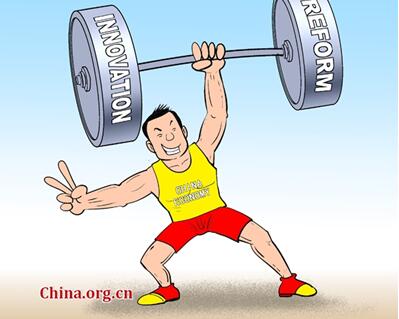FDI, inflation growth show economy warming up
 0 Comment(s)
0 Comment(s) Print
Print E-mail China.org.cn, March 24, 2016
E-mail China.org.cn, March 24, 2016
China's economic indicators put up a mixed performance in January, with FDI and inflation growth showing recovery signs.
 |
|
Weight training |
Foreign direct investment (FDI) continued to grow steadily in January. Excluding investment in the financial sector, it rose 3.2 percent year on year to US$14.07 billion, according to the Ministry of Commerce (MOC).
Investment in the burgeoning service sector accounted for 67.6 percent of total inflow, while that in the high-tech service industry more than doubled to 7.2 billion yuan (US$1.1 billion).
The FDI is a key measure of general overseas investor interest. The January figure showed foreign corporate confidence in the world's second largest economy despite months of cooling.
The consumer price index (CPI), main gauge of inflation, grew 1.8 percent year on year in January due to rising food prices, the National Bureau of Statistics (NBS) reported on Feb. 18.
This marked a slight increase from the 1.6 percent in December and represented a five-month high.
Food prices grew 4.1 percent in January, much faster than the rise of 2.7 percent in December and 2.3 percent in November. Prices in the non-food sector rose 1.2 percent, marginally higher than the 1.1 percent a month earlier.
Pork prices surged 18.8 percent year on year, contributing 0.44 percentage points of the CPI growth while vegetable prices jumped 14.7 percent.
The rise in vegetable and fruit prices was due to supply setbacks during January's extreme cold, while demand for pork and transportation rose before the Lunar New Year celebrations, said NBS researcher Yu Qiumei.
However, despite the higher CPI, inflation growth will remain at a low level in 2016, according to Lian Ping, chief economist at the Bank of Communications, adding, "rising food prices are caused by seasonal factors."
The Producer Price Index (PPI), measurement of inflation at the factory gate, dropped for the 47th consecutive month to 5.3 percent in January. The reading however did ease a little from the 5.9-percent contraction seen from August to December last year.
This narrowing was mostly driven by a lower comparison base last January, the NBS said.
While prices in upstream industries, such as oil, continued to fall, some products downstream, such as ferrous metals, saw slight recovery in January, which might have been a result of China's latest efforts to pursue supply-side reform, including cutting overcapacity in specific industries, according to a study by the investment bank China International Capital Corp (CICC).
"Overall, deflationary pressure remains and leaves room for further monetary policy easing," said Wendy Chen, a Nomura research analyst.
Although the rising CPI in January signaled an easing of deflationary pressure, the market still worried growth might not last.
"The uptick reflects more a seasonal shock to food prices and a reduced drag from commodity costs than strengthening in demand using up spare capacity," said Bloomberg economist Tom Orlik in a research note.
"With virtually the entire increase coming from food prices, it's not an increase that's likely to be sustained for long," he said.
To stimulate the economy, China's central bank cut the benchmark interest rates five times in 2015. Since the last reduction in October, the central bank also lowered the short-term money market rate many times to inject more liquidity into the financial system.






Go to Forum >>0 Comment(s)